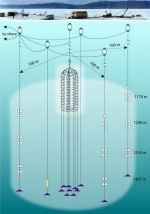 | ||
The Baikal Deep Underwater Neutrino Telescope (BDUNT) (Russian: Байкальский подводный нейтринный телескоп) is a neutrino detector conducting research below the surface of Lake Baikal (Russia) since 2003. The detector was completed in 1998 and was upgraded in 2005. Further expansion to 1000 PMTs is planned. BDUNT has studied neutrinos coming through the earth with results on atmospheric muon flux. BDUNT picks up a lot of atmospheric neutrinos created by solar winds interacting with the atmosphere — as opposed to cosmic neutrinos which can give clues to cosmic events and are therefore of greater interest to physicists.
Contents
Detector History
The original NT-200 design was deployed in stages 3.6 km from shore at a depth of 1.1 km (location: 51°46′17″N 104°23′52″E).
The first part, NT-36 with 36 optical modules (OMs) at 3 short strings, was put into operation and took data up to March 1995. NT-72 ran 1995–1996 then was replaced by the four-string NT-96 array. Over its 700 days of operation, 320,000,000 muon events were collected with NT-36, NT-72, and NT-96. Beginning April 1997, NT-144, a six-string array took data. The full NT-200 array with 192 modules was completed April 1998. In 2004-2005 it was updated to NT-200+ with three additional strings around NT-200 at distance of 100 meters, each with 12 modules.
There are plans to build 1 cubic km telescope, NT-1000, in Baikal. The first stage of 3 strings was switched on in April 2013.
Results
BDUNT has used its neutrino detector to study astrophysical phenomenon. Searches for relic dark matter in the sun and high energy muons and neutrinos were published.
